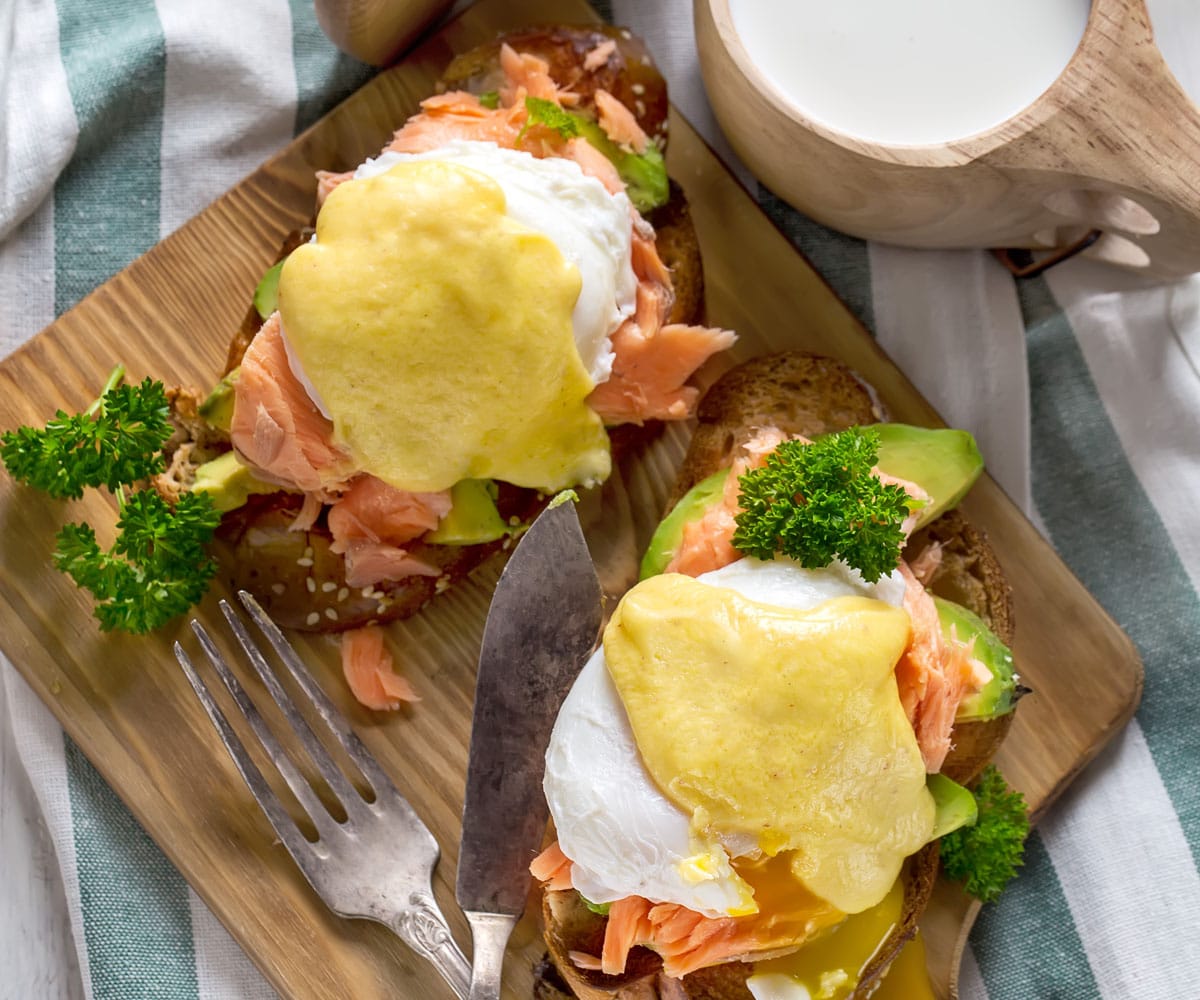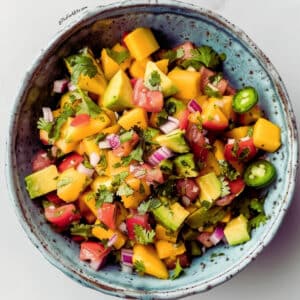The short answer is YES! This specially created emulsion sauce – known for its egg yolk content - can be frozen, lasting for up to one month while in the freezer. However, it would be best to learn the proper storing technique so your Hollandaise sauce won't end up separating.
We will expound on the proper storage method in detail in this comprehensive freezing guide. This and all of the various questions that you may have about the topic of hollandaise sauce will be covered here.

Hollandaise sauce is a mild - yet rich and creamy sauce enriched with a robustly-flavored lemon juice. It pairs perfectly with eggs, a wide assortment of vegetables - such as broccoli and asparagus, beef, and savory grilled seafood. Drizzle it over your egg Benedict or those perfectly poached eggs to put a final touch of pure deliciousness!
It's bright and incredibly silky texture combined with its immense flavoring creates a high level of lusciousness that will result in whatever dish you are creating go from a dull sheen to a glimmering delight.
It does not matter how you elect to describe it or define it; it is a classic, traditional sauce capable of completely transforming any meal. For a matter of convenience, you should always have a little bit of this sauce on hand at all times.
What exactly is hollandaise sauce
Hollandaise sauce is an emulsion-based combination of yolks, creamy melted butter, and lemon juice. In some instances, vinegar reduction or white wine may substitute the lemon juice.
In French cuisine, it is considered one of the popular five varieties of mother sauces. It pairs well with meats, vegetables, and even fish. It is most widely known for being served with the egg Benedict dish.
What does hollandaise sauce taste like?
Imagine a thick, creamy, and exceptionally rich mayonnaise with mild undertones of butter and a bit of a tart sharp of lemon flavoring. The acidic base is not overpowering. It simply provides a delicate balance between the egg yolk and the recipe's butter.
I personally prefer to add a dash of cayenne pepper and a few little drops of hot sauce when I make my hollandaise sauce. This incorporates a whole different acidity layer, and the spice's induction provides a burst of flavor that your palate will thank you for!
For many, the fact that this is an emulsion recipe results in concern over the actual freezing process. Will the sauce getting frozen affect the ingredient mixture?
Once thawed, will its consistency remain the same? As you continue to read this guide, I will expound on this more; however, as long as you follow the correct procedures in freezing and thawing, you will not experience any trouble.
What is it made of?
This sauce is an oil-in-water based emulsion. As mentioned previously, the main ingredients are melted butter, egg yolk, and lemon juice. If you so desire, you may use vinegar or even a white wine reduction in place of the lemon juice.
You may utilize a variety of seasonings to assist in rounding out all of the flavors. These include salt, pepper, a bit of cayenne, and even Tabasco sauce.
Egg yolk and butter – the two main ingredients in hollandaise sauce – are very sensitive to spoilage. It would be best if you stored these appropriately so that they do not go bad.

A simple recipe for hollandaise sauce
This is a straightforward recipe designed for the creation of two servings. You may increase as you wish, based on how much you expect to need for your veggies, fish, meat, or egg Benedict. I prefer this recipe because it helps prevent me from working too hard to create the sauce.
Grab these ingredients
Using a blender
- 1 egg yolk
- a pinch of salt
- 1 stick of butter
- ⅛ teaspoon of Dijon mustard
- 1 teaspoon of Lemon Juice
- a pinch of cayenne pepper or a dash of Tabasco sauce
Step by step directions
Using immersion-based blenders:
- Place the egg yolk, the lemon juice, mustard, and the hot pepper sauce inside of the blender cup and blend for a total of 5 seconds.
- Melt the butter on the stovetop. It should reach a temperature of 220°F and be bubbling. (You may place it in a measuring cup and heat it in the microwave until melted and very hot as an alternative to stovetop heating.)
- Once the butter is ready, place it into a glass measuring cup.
Slowly, start to hand blend that which is inside of the blender cup. As you do this, drizzle in the hot, creamy butter. - The heat from the butter will hit the eggs and will initiate the cooking process of those eggs. Once all of the butter has been added -about 30 seconds later – you will thoroughly cook the eggs. You will immediately find that your hollandaise sauce is ready.
Using a standard blender:
- Set your blender on the high-speed option and slowly drizzle the melted butter over the mixture containing the egg yolk. It will start to thicken nearly immediately.
To maintain the sauce's warmth until you are ready to serve, place your blender glass into a pan that contains hot water from your tap.
How to store the Hollandaise sauce?
Hollandaise sauce will need to be kept warm before serving. It should not reach temperatures between 40°F and 140°F. This is considered the "danger zone" as bacteria can develop and multiply rapidly.
The sauce should be eaten within 2 hours, at most. If this is not possible, you need to save and store it properly.
You will have two options that you may choose from:
- Store in the Refrigerator
- Store in the Freezer
Each of these storage methods will directly impact the emulsion. Cold temperatures will result in the solidification of the butter. The good news is, there are strategies for correcting this issue during the reheating process. Let's delve a little bit deeper into this subject.
Using the refrigerator to store hollandaise sauce
If you want to preserve your remaining hollandaise sauce, refrigeration is considered an ideal option. It will result in an additional two days of usage.
Follow the outlined directions to ensure proper refrigerator storage.
Refrigerating hollandaise sauce:
- Prepare the storage method – either a sealable bag designed for refrigerators or a large bowl.
- Place the sauce within the chosen container.
- If you selected a bag, close the seal. For bowls, cover with a lid that ensures a tight seal.
- Place in a cleared area within the fridge.
- Allow it to remain there for only one to two days.
If you correctly prepared the sauce, it will be easy to work it into your recipes over the two days. You may even add it as a filler to a new batch of hollandaise sauce. Combine, whisk, and ensure a thorough mixture.
Will refrigeration impact the emulsion?
No, it does not affect it. During the cooling process, the butter will solidify. Once it is warmed, though, it will separate, and you can remix it to regenerate the same luscious sauce that you enjoyed previously.
Fixing solidified butter:
- Microwave – I place the microwave on 50% power and heat in increments of 15-seconds, ensuring to whisk between those increments until it is warm, but NOT to the point where it is HOT. The goal is to reach the liquid form.
- Stovetop – You may either place the sauce in a top double boiler pan or a bowl place into a saucepan with simmering water. It should be on ultra-low heat. Keep stirring it frequently until warm.
I've found that by adding a small amount of melted butter, the sauce will easily re-emulsify. Additionally, it creates a very smooth texture.
- Additional Yolk – Instead of adding more melted butter, add in another egg yolk. Then, continually whisk until it reaches your preferred consistency. This renews the sauce.
Once warm, place in the serving bowl and use/serve.
Freezing the hollandaise sauce
Freezing is another highly effective method for storing leftover hollandaise sauce.
I have been freezing mine for many years. Many claims it does not freeze well; however, I've found that it freezes perfectly.
Follow the steps below for freezing this sauce:
- Take an empty ice cube tray and pour the sauce into each of the cubes. Do not allow any spillage to occur. Immediately place in the freezer.
- After about an hour, check the tray to see if the sauce has frozen or has solidified.
Immediately after the sauce freezes into cubes, run cold water over the ice tray bottoms so that the cubes will come out freely. - Take a one-gallon bag designed for freezer storage and put all of the frozen cubes into the bag.
- Completely seal and place in the freezer.
- Whenever you require a bit of the sauce for a recipe, take a couple of cubes out.
As an added note, hollandaise sauce may last up to a month in the freezer if you follow the proper storage technique.
How to thaw out hollandaise sauce
If you have frozen your sauce, you will need to thaw it before serving. It does take some time for it to liquify completely. This must be kept in mind when you require it for a recipe.
Do not place it in the microwave in an attempt to thaw it too quickly. This could ruin the sauce.
Why will it ruin the sauce?
The high level of heat and the immensely rapid temperature rise will ultimately break the sauce's overall emulsion.
Best way to thaw:
- Determine the serving size and place the correct number of cubes into a sandwich bag. For example, if you are making egg Benedict, one or two cubes is needed.
- Place the bag in the refrigerator overnight to allow the cubes to thaw.
You may also place the bag in warm water to liquify the cubes. - It is important to stir regularly and, when possible, evaluate its overall consistency.
After thawing, poke a hole in the corner of the bag and work your sauce to the area so that it may be squeezed through the hole and served. - Remember, the hollandaise sauce temperature does not need to go higher than the regular room temperature.
How to fix broken hollandaise sauce?
Emulsion sauces tend to separate, even on professionally-trained chefs. The good news is, you can fix it!
One of the main reasons for a broken sauce is that the consistency is too thick.
Outlined below are two solutions for this issue:
Option 1
- Whisk ¼ part of hot water gradually into the sauce.
- Once the sauce starts to come together, add one tablespoon of hot water at a time.
- Continue adding the water until you find that the sauce has reached the proper consistency.
- Note: If you prefer, you may use scalded cream in place of the hot water.
Option 2
- Use one egg yolk. Add to a bowl. Slowly, start to whisk in the separated sauce.
If both options don't work, you need to create a fresh sauce all over again.

Pro tips for preventing the sauce from breaking:
- When adding butter, do it slowly. Too fast, and it will not properly combine.
- To stabilize the sauce, add in a teaspoon of Dijon mustard before adding the egg yolks.
- If the sauce becomes too thick when making it, add in a tablespoon of hot water and whisk not to have a chance to separate.
Interesting recipes
- How to Make Cashew Cream
- Chipotle Tuna Salad Stuffed Avocado
- Potstickers Recipe
- Puff Pastry Jalapeno Poppers
Full Recipe
How to Freeze Hollandaise Sauce (How to instructions)
Pin RecipeEquipments:
- blender
- immersion
Ingredients:
- Hollandaise sauce (leftover)
Instructions:
Storing in the Freezer:
- Take an empty ice cube tray and pour the sauce into each of the cubes. Do not allow any spillage to occur. Immediately place in the freezer.
- After about an hour, check the tray to see if the sauce has frozen or has solidified. Immediately after the sauce freezes into cubes, run cold water over the ice tray bottoms so that the cubes will come out freely.
- Take a one-gallon bag designed for freezer storage and put all of the frozen cubes into the bag. Completely sealed it and place in the freezer.
- Whenever you require a bit of the sauce for a recipe, take a couple of cubes out.
Storing in the Fridge:
- Prepare the storage method – either a sealable bag designed for refrigerators or a large bowl.
- Place the sauce within the chosen container. If you selected a bag, close the seal. For bowls, cover with a lid that ensures a tight seal.
- Place in a cleared area within the fridge. Allow it to remain there for only one to two days.
How to Thaw Hollandaise Sauce:
- Determine the serving size and place the correct number of cubes into a sandwich bag. For example, if you are making egg Benedict, one or two cubes is needed.
- Place the bag in the refrigerator overnight to allow the cubes to thaw. You may also place the bag in warm water to liquify the cubes.
- It is important to stir regularly and, when possible, evaluate its overall consistency. After thawing, poke a hole in the corner of the bag and work your sauce to the area so that it may be squeezed through the hole and served.
- Remember, the hollandaise sauce temperature does not need to go higher than the regular room temperature.
Notes:
How to fix broken hollandaise sauce?
Emulsion sauces tend to separate, even on professionally-trained chefs. The good news is, you can fix it! One of the main reasons for a broken sauce is that the consistency is too thick. Outlined below are two solutions for this issue:Option 1
- Whisk ¼ part of hot water gradually into the sauce.
- Once the sauce starts to come together, add one tablespoon of hot water at a time.
- Continue adding the water until you find that the sauce has reached the proper consistency.
- Note: If you prefer, you may use scalded cream in place of the hot water.
Option 2
- Use one egg yolk. Add to a bowl. Slowly, start to whisk in the separated sauce.
Pro tips for preventing the sauce from breaking:
- When adding butter, do it slowly. Too fast, and it will not properly combine.
- To stabilize the sauce, add in a teaspoon of Dijon mustard before adding the egg yolks.
- If the sauce becomes too thick when making it, add in a tablespoon of hot water and whisk not to have a chance to separate.
Please note that all nutrition information are just estimates. Values will vary among brands, so we encourage you to calculate these on your own for most accurate results.
Related questions
Both storage methods are useful, but you need to ask yourself how much leftover and how long until you plan to use it.
For small amounts, refrigerating is best. For large batches, freezing is best. If you plan to consume it within a couple of days, store it in the fridge. If you are unsure whether you will finish or for later meals (past two days), freezing is best.
This is one of the main ingredients of the sauce. Yes, you may freeze them; however, you should prepare the yolks before initiating the freezing process.
Egg yolks are known to thicken on their own, which makes freezing a bit of a tricky situation; however, you may use salt or sugar to help eliminate the thickening issue.
1.) Separate the yolks from the rest of the egg and place them in a bowl.
2.) Beat gently into liquid form.
3.) For savory dishes, add ½ of a teaspoon of salt for every cup of yolks.
4.) If making desserts, substitute the salt with sugar and add 1 ½ teaspoon of sugar (or corn syrup) for every cup of the yolks used.
5.) Place the yolk in an ice cube tray and freeze. Don’t forget to label the date.
6.) Use within four months from the date of placement.
Tip: Salt or sugar helps to prevent the egg yolks from becoming gelatinous.





